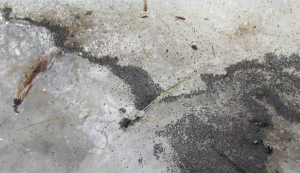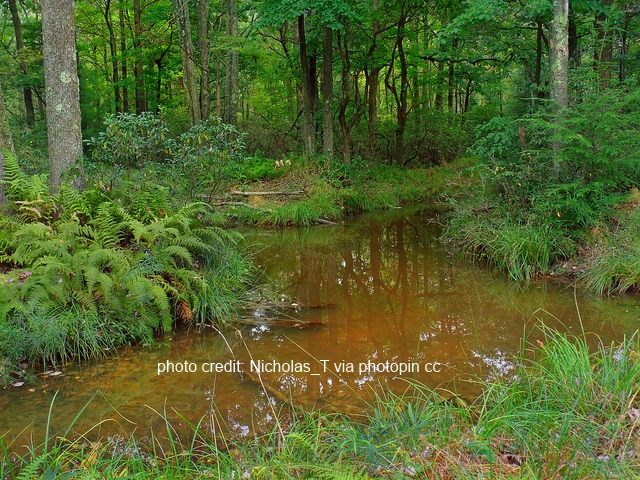Water Closet for March 28, 2014
Last Thursday, the 20th of March, the sun shown directly down on the equator. Had we a sextant and gone out at proper noon when the sun was highest and straight south above our meridian we would have found its altitude here about 47 degrees above the horizon. For three months after, it rises about a degree higher every 4 days giving its warmth ever more meaning. Soil and water bodies warm. This warming has already been seen this March as puddles form on the snow in sunny afternoons despite freezing air. [pullquote]”Some small frogs and salamanders jump and crawl over 5000 times their own lengths to get to the temporary ponds”[/pullquote] Stream Teamer, Elaine Gauthier, recently photographed great masses of a tiny insect called springtails on snow puddles.1 On the north edges of our ponds, the combination of sun melting and ground water seeping in at about 55 degrees Fahrenheit have made this winter’s thick ice thin or gone.

This time of year seemingly out of nowhere tiny insects called springtails gather as seen in these patches on the ice and snow of a woodland road. Only 1/16 to 1/8 inches long, there are many millions in these masses attracted to late winter sun melted puddles. If not on snow they are not noticed. – Elaine Gauthier photo
The perimeters of our gray-white ice covered ponds receiving full sun are partially framed in open water. The south edges of woodland ponds and lakes in some shade are still largely ice; however, not for long. Ground water is seeping in from all around. Near the ice melting in ponds, water temperatures are 32 degrees. The dark mud bottoms under clear water around the edges absorb light which warms, further signaling organisms to emerge. Day lengths, ever longer now, also send such signals. Around-pond-hikers will soon see moving crustaceans, insect larvae, and other small creatures swimming and crawling. Spring is biologically as well as astronomically here.
Now naturalists and other outdoorsy types await the dynamic waves of amphibian reproduction that will soon be visible to human voyeurs. Every spring we marvel at their migrations to ponds called vernal pools.2 Some small frogs and salamanders jump and crawl over 5000 times their own lengths to get to the temporary ponds where they hatched after their parents’ cold water trysts in previous springs. Blue-spotted salamanders, the length of our fingers, have been found to travel from burrows in forest duff and topsoil 1200-feet as the crow flies only on the up and down surfaces of mountains, knolls to us, to reach their natal pools. If the up and down routes were flattened and straightened out their distances over the ground might tally a mile or more. The hundreds of sticks encountered are as large logs would be to us. Even last year’s oak leaves must present a problem. Imagine a human hiker walking on clutters of overlapping, flattened, cardboard refrigerator boxes.
Many zoologists might object to our being so anthropomorphic. We imaginers of animals’ lives make no apologies especially now that the wonderful John Muir is back in the Closet with us after an 18 year absence. An old Closeteer took out a tome he’d last read in 1996, as indicated by a Middleton librarian’s stamped date, of the superb writer’s works.3 The Closeteer is again happily reading the often glorious paragraphs, and too frequently interrupting us with readings from it. Muir from early childhood in Scotland was acutely sensitive to human characteristics he saw in animals and vice versa. Later as an overworked boy on his family’s pioneer farm in Wisconsin, he reveled in observing the behavior of farm and wild animals. He was sympathetic to their moods, cries, songs, and quests for food. Muir saw a kindred wildness in himself and exulted in it. His zealously religious Scottish father, who did everything he could to beat it out of him, clearly failed.
Last week in an oak wood pocked by vernal pools, the old Closeteer inspired by Muir’s hikes, climbs, and crawls in America’s wild places, got down on his hands and knees, eyes near the ground, and pretended to be a spotted salamander heading for his vernal pool. Younger, he would have played a wood frog and hopped. He was not driven by hormones, but rather by curiosity. His admiration of amphibious pilgrims rose as he encountered unending obstacles hardly noticed while walking with human strides, eyes five feet above the ground. By 200-feet, less than forty times his own length, he was exhausted with hurting knees.
What a treat it would be to hike or even crawl in our area with someone like geologist, botanist, ornithologist, conservationist, story teller, and writer Muir. He would be ecstatic among the spring activities of our animals and plants as he always was. His flesh joined the natural cycles he so loved one hundred years ago, but we have his words, and his spirit fills the air especially this time of year. He’ll be with us, breathing the softer air, when we visit vernal pools under the swelling buds of trees.
You are welcome to join the Stream Team on its 15th or so annual spring hike to pools in Middleton and just over the line in North Reading. Several hundreds of these lively important, more or less temporary pools without predacious fish are in the Ipswich River Watershed.
See invitation below.4
1 Here is a poem about Collembola, the spring tails: Spring Tale – On snow in sun made puddle/The springtails form a scum/And left for us to muddle/From where on Earth they’d come.
2 If you’d like to know about these pools so full of diverse life, we recommend A Field Guide to the Animals of Vernal Pools by local naturalists Leo P. Kenny and Mathew R. Burne. It is a very good guide, well illustrated with the authors’ photos. To go deeper we recommend Vernal Pools by Dr, Elizabeth Coburn aquatic ecologist at Harvard Forest, Petersham, Massachusetts.
3 Muir, John. Nature Writings (selected works) The Library of America 1992.
4 Families are welcome to join us Sunday, April 6, by 1 PM, at the Lake Street entrance to the Middleton Pond reservoir about one-fourth mile west of Middleton center. We’ll be back at start before 4 PM. See our website for more info–>
__________________________________________________________________________
WATER RESOURCE AND CONSERVATION INFORMATION
FOR MIDDLETON, BOXFORD AND TOPSFIELD
| Precipitation Data* for Month of: | Dec | Jan | Feb | March | |
| 30 Year Normal (1981 – 2010) Inches | 4.12 | 3.40 | 3.25 | 4.65 | |
| 2013 – 14 Central Watershed Actual | 5.30 | 3.47 | 4.34 | 1.90 as of 3/25** | |
Ipswich R. Flow Rate (S. Middleton USGS Gage) in Cubic Feet/ Second (CFS):
For March 25, 2014: Normal . . . 155 CFS Current Rate . . . 116 CFS
*Danvers Water Filtration Plant, Lake Street, Middleton is the source for actual precipitation data thru Feb. Normals data is from the National Climatic Data Center.
**Updated March precipitation data is from MST gage.
THE WATER CLOSET is provided by the Middleton Stream Team: www.middletonstreamteam.org or <MSTMiddletonMA@gmail.com> or (978) 777-4584

A new children’s book, The Secret Pool by Ridley and Raye opens the magical world of vernal pools to the young among us. Next week, the book will be honored at New York’s Museum of Natural History. It provides a way into the wonder that John Muir found through the experience of his early life.
Bob Curry